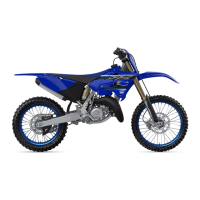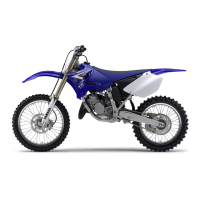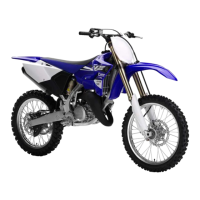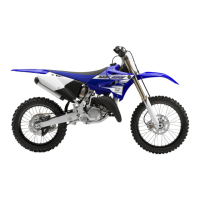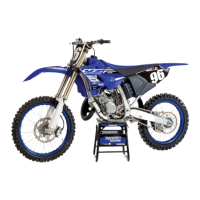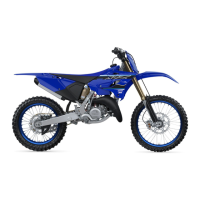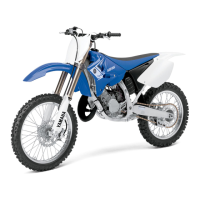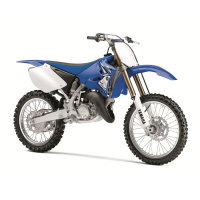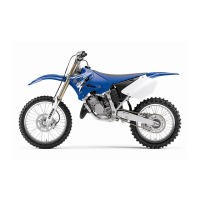Do you have a question about the Yamaha YZ125 2022 and is the answer not in the manual?
Essential safety precautions and guidelines for operating the vehicle.
Identifies the locations of crucial labels on the vehicle.
Provides a detailed overview and identification of vehicle components.
Explains how to identify the vehicle using serial numbers.
Lists and illustrates parts included with the vehicle.
Crucial details regarding disassembly, parts, and maintenance procedures.
Lists and describes specialized tools required for service and assembly.
Explains the operation of various instruments and controls on the vehicle.
Procedures for starting the engine and initial break-in of the vehicle.
Comprehensive maintenance checks for the engine and chassis.
Instructions for cleaning and maintaining the air filter element.
Crucial torque values for standard fasteners and components.
Detailed steps for cleaning the motorcycle safely and effectively.
Instructions for storing the motorcycle for short or long periods.
Overall dimensions, weight, and capacity specifications of the vehicle.
Detailed technical specifications related to the engine and its components.
Technical specifications for the vehicle's chassis, suspension, and brakes.
Technical specifications for the vehicle's electrical system components.
Visual guide for the correct routing of cables and wires on the vehicle.
Recommended intervals for performing various maintenance tasks.
Essential checks and maintenance before operating the vehicle.
Maintenance and adjustment procedures for the engine.
Maintenance and adjustment procedures for the vehicle's chassis components.
Maintenance and troubleshooting for the vehicle's electrical system.
How to adjust the pilot air screw for optimal fuel mixture.
Procedure for checking and adjusting the engine's idling speed.
How to check and adjust the throttle grip's free play.
Steps for checking the condition and gap of the spark plug.
How to check the transmission oil level and add oil if necessary.
Procedure for draining and refilling the transmission oil.
How to adjust the free play of the clutch lever for proper operation.
How to adjust the position of the clutch lever.
Detailed steps for cleaning and re-oiling the air filter element.
How to check the carburetor joint for cracks or damage.
Inspection of fuel and vacuum hoses for damage or loose connections.
Inspection of the exhaust pipe, silencer, and fiber for damage or wear.
Procedure for checking the coolant level in the radiator.
Inspection of the radiator and hoses for leaks or damage.
Steps for draining and refilling the engine's cooling system.
How to adjust the front disc brake lever position for optimal feel.
How to adjust the rear brake pedal position for proper operation.
How to check the brake fluid level in the reservoir.
Procedure for checking the wear on the front brake pads.
Procedure for checking the wear on the rear brake pads.
Inspection of the front brake hose for cracks or damage.
Inspection of the rear brake hose for cracks or damage.
How to check the overall operation of the front and rear brakes.
Procedure for removing air from the hydraulic brake system.
How to check and adjust the drive chain slack for proper tension.
How to check and adjust the steering head for proper tightness and smooth operation.
Inspection of the front fork legs for damage, leaks, and proper operation.
How to adjust the rebound and compression damping of the front fork.
Inspection of the rear shock absorber for leaks and smooth action.
How to adjust the spring preload and damping of the rear shock absorber.
How to check the swingarm for smooth action and free play.
How to measure tire pressure and check tire condition.
Procedure for checking spoke tension and tightening them.
Inspection of wheels for damage or runout.
How to check the condition of wheel bearings.
Ensuring all chassis bolts and screws are properly tightened.
How to check and lubricate control cables for smooth operation.
Lubrication points for the brake lever.
Lubrication points for the clutch lever.
Lubrication points for the brake and shift pedals.
Procedure for checking and adjusting the engine's ignition timing.
General procedures for removing chassis parts like covers and plates.
Procedures for removing, disassembling, checking, and installing the front wheel.
Procedures for removing, checking, and installing the rear wheel and sprocket.
Detailed steps for removing, disassembling, checking, and installing front brake components.
Detailed steps for removing, disassembling, checking, and installing rear brake components.
Procedures for removing, checking, and installing the handlebar and its controls.
Procedures for removing, disassembling, checking, and assembling front fork legs.
Procedures for removing, checking, and installing the steering head assembly.
Procedures for removing, handling, checking, and installing the rear shock absorber.
Procedures for removing, checking, and installing the swingarm.
Procedures for removing, checking, and installing the drive chain and sprockets.
Steps and diagrams for removing the engine from the motorcycle.
Procedures for removing and servicing cylinder head, cylinder, and piston.
Information on removing and checking the CDI magneto system.
Procedures for removing and installing kickstarter components.
Information on removing and installing the YPVS governor system.
Procedures for removing, checking, and installing the clutch assembly.
Procedures for removing and checking the shift shaft and related parts.
Procedures for separating, checking, and assembling the crankcase.
Procedures for removing, checking, and installing the crankshaft.
Procedures for removing, checking, and installing the transmission components.
Diagrams illustrating the layout of the cooling system components.
Procedures for removing and checking the radiator.
Procedures for removing, checking, and assembling the water pump.
Procedures for removing and installing the fuel tank.
Procedures for removing and installing the air filter element and case.
Procedures for removing, disassembling, checking, and installing the carburetor.
Schematic diagram illustrating the vehicle's wiring layout.
Troubleshooting and checks for the ignition system.
Troubleshooting for the solenoid valve system.
Troubleshooting for the throttle position sensor system.
Identification and checks for key electrical components.
How to check electrical switches for continuity and proper function.
Procedure for checking and adjusting the ignition spark gap.
How to check the resistance of the spark plug cap.
How to check the resistance of the ignition coil's primary and secondary windings.
How to check the resistance of the pickup coil.
How to check the resistance of the source coil (charging coil).
How to check if the solenoid valve operates correctly.
How to check the resistance of the solenoid valve coil.
Important notes on handling the throttle position sensor.
How to check the resistance and variable resistance of the TPS coil.
Procedures for replacing and adjusting the throttle position sensor.
How to check the input voltage for the throttle position sensor.
General notes and guidance for using the troubleshooting section.
Diagnosing and resolving engine-related starting and running problems.
Diagnosing and resolving issues related to clutch operation and noise.
Diagnosing and resolving problems with gear shifting and transmission noise.
Diagnosing and resolving issues related to engine overheating and cooling system noise.
Diagnosing and resolving problems with brake performance and fluid.
Diagnosing and resolving issues related to front and rear suspension performance.
Diagnosing and resolving issues related to steering, handlebar wobble, and vibration.
Carburetor settings and adjustments for optimal engine performance.
Adjustments related to chassis settings like sprockets and suspension.
General guidelines for setting up the carburetor based on conditions.
How atmospheric conditions affect carburetor settings.
Procedure for test running the vehicle to check engine performance.
How to adjust the main jet for optimal air-fuel mixture.
How to adjust the power jet for mixture control at higher RPMs.
How to adjust the pilot air screw for low-speed mixture control.
How to adjust the pilot jet when air screw adjustment is insufficient.
Explanation of jet needle settings and their effects on mixture.
How to adjust the jet needle clip position for mixture tuning.
List of carburetor parts and their part numbers for tuning.
Recommended carburetor settings based on road conditions and temperature.
Troubleshooting carburetor symptoms with corresponding setting adjustments.
How to select and change spark plugs based on heat range and performance.
Guidance on selecting the appropriate rear sprocket for desired performance.
Recommended tire pressures for different riding conditions.
Adjusting front fork settings like air spring, preload, and damping.
How fork oil amount affects damping characteristics.
Adjusting suspension after replacing springs for proper balance.
Specifications for front fork springs.
Adjusting rear suspension preload and damping force.
How to choose and set the suspension length.
Adjusting suspension after replacing springs for proper balance.
Adjusting front fork settings for various riding conditions and symptoms.
Adjusting rear shock absorber settings for various riding conditions and symptoms.
| Displacement | 125cc |
|---|---|
| Bore x Stroke | 54.0mm x 54.5mm |
| Ignition | CDI |
| Transmission | 6-speed; multiplate wet clutch |
| Final Drive | Chain |
| Front Suspension | KYB® inverted fork; fully adjustable, 11.8-in travel |
| Rear Suspension | KYB® single shock; fully adjustable, 12.4-in travel |
| Front Brake | Hydraulic disc, 270mm |
| Rear Brake | Hydraulic disc, 240mm |
| Front Tire | 80/100-21 |
| Rear Tire | 100/90-19 |
| Width | 32.5 in |
| Height | 51.2 in |
| Seat Height | 38.6 in |
| Engine Type | Liquid-cooled 2-stroke |
| Fuel Delivery | Keihin PWK38S carburetor |
